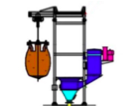Bulkagram 15 , 3 November 2022.

For efficient handling of bulk materials there are a large number and variety of equipments that can be supplied and installed in the plant for reliable and economic operation. Because the handling of the product does not end with its passage through a single equipment, the interface between a series of equipments that perform the function of say, material receipt, have to be invariably interlinked and interfaced as an independent system with its own controls and operational sequences. The plant engineer has to make a considered choice based on the properties of his bulk material. To help him select and specify the system or equipment best suited to his particular requirement, we will now go through a step by step procedure for helping him with his job.The variety of bulk powders being handled in industry covers powders over a large range of size, shape and characteristic all of which play a crucial role in the choice of your handling system.
Step-1: The material properties that will influence his choice will include:
Bulk density
Minimum / maximum particle size
Particle properties
Size distribution
Environmental considerations like
toxicity
Type of product, whether chemical,
mineral, organic, inorganic, pharmaceutical, food based, agro- based etc. etc.
Contact us : marketing@scorpiobmh.com For a detailed data sheet for material properties
While there are a host of other properties under each of these heads, the best approach would be to list all chemical and mechanical properties including those of flow, static behaviour and dynamic behaviour. The starting point for equipment and system selection is certainly this listing of product properties and the greater the detail, the closer the plant engineer is to selecting an optimum system or equipment for his application. A Material Properties Chart will list all chemical and mechanical properties of the material. Each of the listed properties will now have to be looked at in detail to arrive at the optimum handling equipment. For example, bulk density is not a single constant figure. One has to contend with loose , poured and tapped bulk density. Each one of these figures will be different from the others and the plant engineer has to relate these properties to the function he wants to perform. If he is storing his product for a long time in a large storage silo, the stored bulk density for a product that retains air will be much higher than the bulk density when it is freshly aerated (as when it comes out from a sack or conveyed pneumatically). He has to therefore design his silo volumes for the stored bulk density and not as per the poured or aerated bulk density. Likewise, if the product is friable and breakage unacceptable, handling by pneumatic conveying is ruled out. Potato wafers or corn flakes for example should not be conveyed pneumatically into the packing plant unless the market can accept pulverized wafers!
Step-II: Having listed the material properties above, the next step will be to determine the first operation in the handling of the bulk material. This is invariably the receipt of the product into the plant from the supplier. The bulk material can come into the plant in a variety of forms such as small bags in 25 to 50 kg. capacities, big bags (Jumbo bags, FIBCs) in capacities of 1000 to 2000 kg., in linered containers in capacities of 25 – 30 ton (depending on bulk density), in loose open bulk or in bulk tankers. The system for receipt and subsequent storage is directly dependent on the method by which the product arrives at the plant. If the product arrives in a number of these modes or if there are number of products arriving in one or all of these modes, the selection becomes more complicated as there is no single method that is universal.

Step-III: The overall handling requirement of the bulk product has to be first determined in the form of a flow sheet and this is best done through meetings with process engineers responsible for the product manufacture. This flow sheet will identify the various stages that the product has to pass through before it is physically or chemically converted. The bulk handling engineer’s job ends prior to his bulk product being physically or chemically converted to a form other than powder. By studying this flow sheet, the plant engineer will have an idea of his total handling requirement. However, he will no have an idea of the number of times he has to handle the product unless a plant layout is tentatively made. Because costs of production include the cost of factory building, civil engineers must be involved in the discussions that will determine optimum handling methods within the plant. A planning document that has the flow sheet integrated into the plant layout is now required to get closer to the proper selection of the overall handling system for the bulk material. The plant layout will determine the number of times the material has to be handled and whether any improvements can be made in reducing handling stages. The best option at this time would be to simply elevate the bulk material to the highest possible level and let gravity do the rest. This is easier said than done considering the cost of high buildings and a variety of other processing requirements within the flow scheme of the bulk product. At this point, the computation of a Handling Coefficient for your plant will make things interesting.
HANDLING COEFFICIENT HC FOR BULK HANDLING PLANT = (HMV+VMV+IMV)/(FSD+TS+PS)
where
HMV = Horizontal Movement Vector
VMV = Vertical Movement Vector can be either Static Process
IMV = Inclined Movement Vector
PS (Process Stations, Static, SPS and Dynamic,DPS)
FSD = Free Space Distance Station
TS = Transfer Station
Example:
HMV=12 VMV=3 IMV=0 hence HMV +VMV+IMV=15
TS=3 SPS=6 DPS=1 FSD=11 hence FSD+TS+PS = 21
Handling Coefficient =15/21 =0.71
The movement vectors defined above mean the number of movements you need to make to handle your bulk material.
Further details are available in the paper. (Please see “Importance of Plant Layout in Bulk Handling Plant Design”, paper presented at the 2001 Powder Show)
The higher the HC, the more expensive your handling plant.
Step-IV: Identify the range of equipments that can do the job
Having determined the kind of handling, conveying and storage that is required, the most difficult part is to find and match equipments that will perform unit functions within each area and then interfacing them to perform as a whole without mismatch between equipment operating capacities or capabilities. This will require lengthy discussions with vendors of such equipment and it is wise at this stage to get a second or third opinion from fellow users as many vendors are only familiar with their own equipment and will no be able to predict what happens if there are problems within the bulk material processing prior to or after it passes through their equipment. Bulk material handling consultants are few and far between and know more about the equipment they have been familiar with immediately prior to their becoming consultants.

Step-V: Determine and list Handling, Conveying and Storage Requirements:
A detailed list of the handling, storage and conveying requirements must now be made with respect to the flow sheet as well as with respect to the tentative plant layout now available. The plant engineer will now recognize individual areas where materials have to be either lifted, lowered, moved, conveyed, stored, discharge mixed, blended, filled, batched etc. etc. These areas will have to be identified. For example, if there is need somewhere along the flow scheme for product to be lifted from level A to level B (Say 5m) over a 45 deg. slope, there is a particular equipment that will do this job at the highest efficiency and lowest cost. If however, the 5m level distance between A and B becomes 10m, the equipment first selected cannot be used and one has to look at another handling system. Such seemingly small changes in the handling requirements have a large influence on the handling method finally selected. It is here that many engineers make mistakes leading to an inefficiently engineered plant which generally gives a bad name to the industry without having identified the root cause.
Step VI: Match equipments identified in step IV to requirements listed in Step V. You are now ready with a reasonable flow sheet that meets your plant requirements.
Thanks for reading LEARN BULK! Subscribe for free to receive new posts and support my work.
